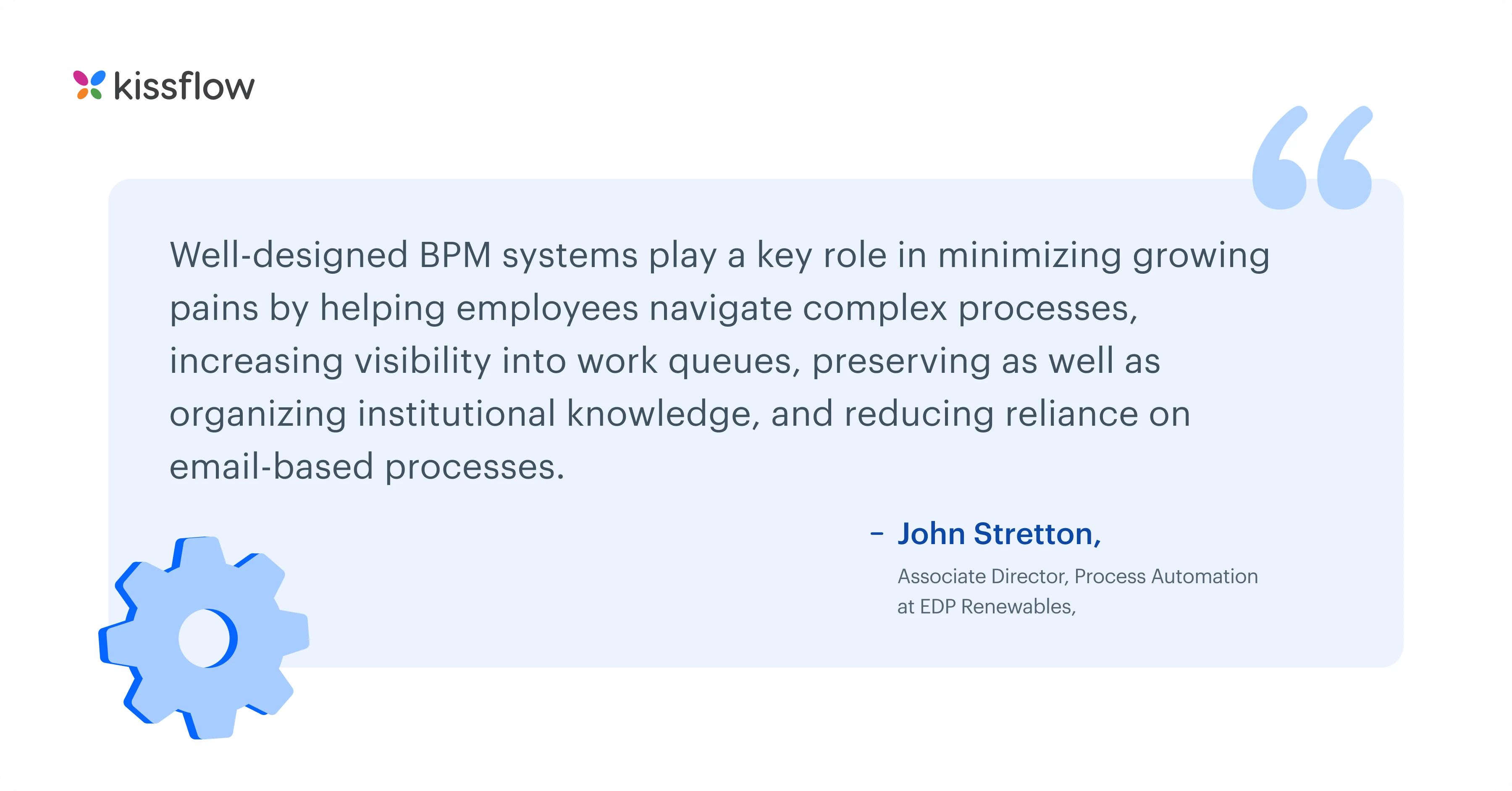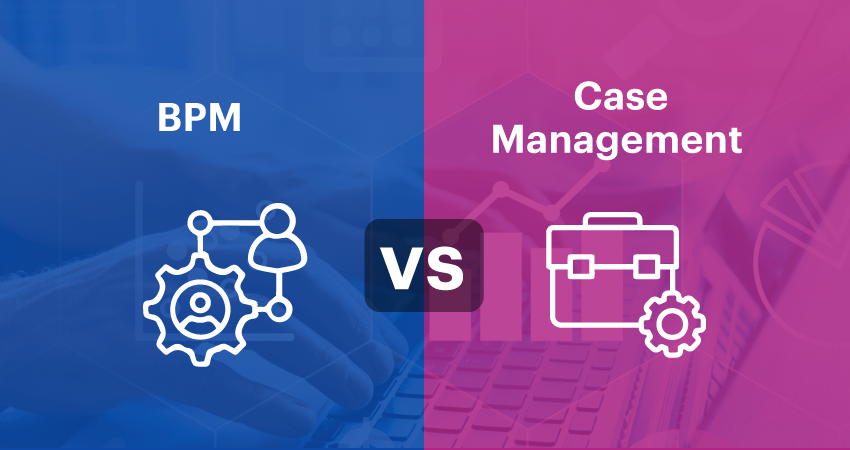Business process management and case management are both two ways to build seamless processes. Both have very similar infrastructure and overall architecture. However, the many other similarities can create confusion on which solution to use in streamlining and automating business processes.
For enterprises, adopting both BPM and case management is necessary to achieve organizational efficiency and adaptability. Instead of choosing one over the other, CIOs should prioritize a combined approach as part of their digital transformation strategy to manage varying complex business processes and unstructured cases effectively.
What is business process management (BPM)?
Business process management (BPM) refers to how organizations define and implement structured business processes. It is a long-term strategy of automating repeatable processes to improve work efficiency. It involves actions and decisions that a business makes on a regular basis.
Some processes that can be streamlined through BPM are employee onboarding, procurement, budget approval, documentation, loan approval, and customer tracking.
When agility is key, enterprise case management may provide a more flexible alternative to traditional BPM frameworks.
BPM software is often used to automate systems for consistency and easy retrieval of data. It digitizes manual processes to eliminate the use of flowcharts, forms, and emails.

What is case management?
Case management is the handling of cases through a variety of processes until a specific objective is achieved. It has a defined goal and requires human judgment to decide each course of action. It involves the gathering of data from several sources and coordinating the resolution of a case.
Case management software can be utilized in different industries such as healthcare, legal firms, financial institutions, and medical centers. It’s most useful in crisis intervention, service plan implementation, service coordination, and case conferencing.
A case management solution may comprise several BPM processes. It’s a highly adaptive and dynamic framework that provides solutions to problems or issues that require profound and complex thought processes.
BPM vs Case Management – How do they differ?

In a nutshell, BPM provides a well-defined end-to-end process while case management provides solutions based on loosely-linked processes.
While both BPM and case management offers solutions for dealing with business processes, BPM vs case management differs in three main areas: complexity, approach, and management.
1. Complexity
Case management is definitely more complex than business process management.
BPM places emphasis on single workflow processes and their efficiency. Case management, on the other hand, deals with a complex set of processes in handling cases. It involves hordes of data and intervention by multiple people or departments.
2. Approach
Business process management uses a process-centred approach, while case management has a data-centric task-oriented approach.
In BPM, tasks are bound to processes. There is a pre-defined process flow that determines the sequence of events. All events are linked to one another with a task directly affecting the one right after it.
In case management, events or actions determine the process. The next event in the process is determined by the input of data from various sources. These can be refined at any time during the resolution of the case.
3. Management
In handling data, business process management follows a structured workflow, while case management workflow follows a highly adaptive one.
There is a structured sequence of processes in BPM. The process flow is formulated in advance and usually entails just a single flow model. Activities are logical, and repeatable sequences can be automated.
On the contrary, there is an unstructured progression of a case from initiation to resolution in case management. The process flow is highly dynamic and allows for ad hoc decision-making. Knowledge workers primarily determine the course of action based on their judgment on the information or circumstances presented.
What are the Pros and Cons of BPM and Case Management?
If you’re still uncertain whether you need case management or business process management, consider the pros and cons of each business solution.
Advantages of BPM
- It automates and improves routine processes that do not require complex thought.
- It does not require human intervention during the process.
- It reduces human error and minimizes risks.
- It tracks performance and productivity.
- It ensures transparency and compliance to policies.
- It increases productivity and efficiency among workers.
- It sets in place consistent guidelines on how a process should be handled by everyone.
- It can be customized to suit the requirements of any business.
- It eliminates redundancies by removing duplicated tasks.
- It improves collaboration and keeps everyone updated on timelines.
Disadvantages of BPM
- It does not allow for processes to be repeated.
- It tends to limit innovations due to its highly rigid framework.
- Its structure does not allow flexibility for employees to work on solutions in whatever way they deem fit.
- It usually requires the help of outside consultants who are more knowledgeable about the tools needed to implement BPM.
- If not implemented properly, it wastes time and funds.
Advantages of Case Management
- It can efficiently manage unstructured data and promptly resolve complex cases.
- It enables the handling of cases by multiple people in a single user interface.
- It leads to more effective collaboration between teams or departments.
- It allows for specific courses of action to be adjusted to achieve optimal results.
- It facilitates the easy gathering, organizing, and sharing of data.
- It integrates databases and provides quick access to pertinent information.
- It expedites the generation of reports to track status and monitor processes.
Disadvantages of Case Management
- It is document-intensive. External documents still play a key role in providing records that can be used in resolving similar cases.
- It requires human intervention, and decisions can still be affected by biases.
- It may require employing the services of a software specialist to handle the backend of the system.
Examples of business process management and case management
BPM in manufacturing: BPM can be leveraged in a manufacturing company to optimize the overall production process. A streamlined workflow can be created, establishing steps from raw material procurement to shipment of final products. Automation can be used for inventory management and quality control. With continuous monitoring, BPM can also identify bottlenecks, save costs, and streamline operations across the organization.
Case management for customer service: Customer service representatives in large e-commerce use case management platforms to provide more personalized support and tailored solutions to end customers by accessing past interactions, customer history, and specific customer preferences.
Which one is better: BPM or Case Management?
As you can see, BPM and case management both have their advantages and disadvantages. This just goes to show that there isn’t any one perfect solution for streamlining business processes.
Instead of choosing one over the other, you can utilize both systems. When used together, they can significantly improve efficiency through a mix of structured and dynamic processes.
Kissflow is a low-code tool that allows you to streamline both business process management and case management through a centralized platform. With its visual drag-and-drop form builder, you can design and automate workflows in just a few clicks.
With, Kissflow you can build and manage strategic business applications that can optimize your processes and drive business growth. Solve your workflow challenges with Kissflow Platform and optimize your team's productivity.
Frequently Asked Questions:
1. How does BPM differ from case management?
Business Process Management (BPM) focuses on standardized, predictable processes with clearly defined steps, while case management handles variable, knowledge-intensive work where paths may change based on emerging information. BPM emphasizes efficiency and consistency; case management prioritizes flexibility and context-specific responses.
2. What are the advantages of BPM over case management?
BPM excels at standardizing routine processes, enabling precise measurement and optimization, ensuring compliance through enforced procedures, and scaling efficiently across large operations. It provides greater predictability and control for high-volume, repeatable work.
3. What industries prefer case management over BPM?
Industries with complex, knowledge-based work such as healthcare, legal services, insurance claims, social services, and financial compliance typically prefer case management. These fields require adaptive problem-solving where each case may follow a unique path based on specific circumstances.
4. How does AI enhance both BPM and case management?
AI enhances BPM through process simulation, intelligent automation, predictive analytics, and automated decision-making. In case management, AI enables intelligent routing, content analysis, predictive resolution, and natural language processing, reducing processing time by 40-50% while improving accuracy and resource allocation.
5. What are common challenges in choosing between BPM and case management?
Organizations struggle to identify which processes are standardizable versus case-specific, face resistance from teams accustomed to current methods, encounter integration challenges with existing systems, and must balance control with necessary flexibility when choosing between BPM and case management.
